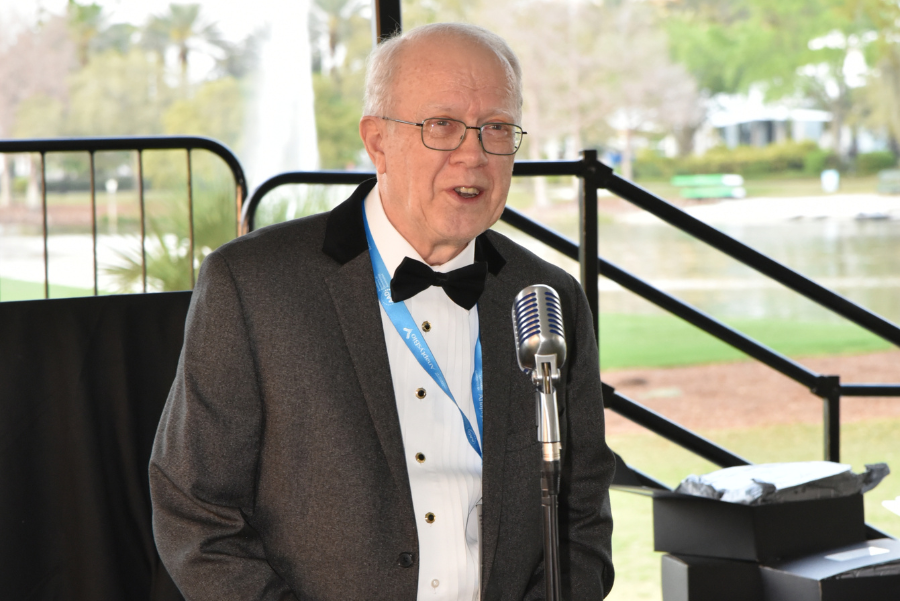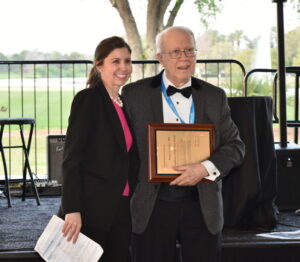A Champion of Patient Safety and Education
James S. Taylor, MD, recipient of 2025 DF Practitioner of the Year Honorary Award
September 2025

Dr. James Taylor has dedicated his career to the Cleveland Clinic, embodying its mission of patient care, education, and research, the very values for which he received the Dermatology Foundation’s 2025 Practitioner of the Year Honorary Award.
Taylor’s career is inextricably linked to the Clinic, where he has worked continually since graduating from the Indiana University School of Medicine in 1966.
From intern to icon
Engaged, inspirational, and not just a little revered, Taylor founded and served as head of the Section of Industrial Dermatology, developed the Cleveland Clinic Patch Test Clinic, created a fellowship in Contact and Environmental Dermatology, and was the first Quality Improvement Officer for the Dermatology-Plastic Surgery Institute.
He is also the author and co-author of 435 scientific articles, abstracts, letters and book chapters. He is editor-in-chief emeritus of the Cleveland Clinic Journal of Medicine and was former deputy editor of the American Journal of Contact Dermatitis.
Among his many honors are seven eponymous lecture presentations; gold, silver and bronze teaching exhibit awards, and Master Dermatologist Award (2024) from the AAD; presidential citations from the AAD, ACDS and ODA; honorary membership in the AAD, ACDS, Canadian Dermatological Association, and the Mexican Academy of Dermatology.
ADA President Dr. Kenneth Tomeki says of Taylor: “His knowledge is fresh, amazingly current, and remarkably relevant. Though semi-retired, he continues to share his knowledge and expertise on a regular basis as clinician/teacher at the Clinic and elsewhere, invariably at dermatology meetings, where he is still a welcomed speaker and participant.”
In the field
Taylor began his career at the Clinic as a PGY-1 intern and completed his dermatology residency program by 1970. A two-year public health service obligation led him to the National Institute for Occupational Safety and Health (NIOSH) in Cincinnati, Ohio; an experience that sparked Taylor’s passion for occupational dermatology and safety.
At NIOSH, Taylor participated in several epidemiologic studies and investigated outbreaks of occupational skin disease. Much of the work took place in New Jersey, one of the few states that regularly requested federal assistance. Taylor would go on to become a sought-after federal resource for much of his career.
DF Practitioner of the Year Award: What it Takes
The DF Practitioner of the Year Award honors an individual who skillfully blends all professional activities with an enduring commitment to being a dermatologist and who provides the best possible clinical service to each patient. Each year, a colleague whose outstanding record of private practice and professional leadership establishes them as model physicians and examples of excellence and commitment for their colleagues and future generations of dermatologists is the recipient of this award.
Because of his increasing expertise in occupational outbreaks, Taylor was asked to consult on industrial accidents nationally and internationally: an outbreak of chloracne in the early 1970s linked to a cotton herbicide; an industrial accident in Seveso, Italy in a factory that produced the chemical trichlorophenol, which, when overheated, was accidentally vented into the surrounding area as a toxic cloud containing dioxin (TCDD).
A few years later, Taylor spent two weeks in Taiwan with a multidisciplinary team from the U.S. National Institute of Environmental Health Sciences (NIEHS) and National Taiwan University investigating another outbreak of chloracne and mass poisoning of about 2,000 people caused by ingestion of cooking oil contaminated with thermally degraded polychlorinated biphenyls (PCBs). A similar event had happened in Japan some ten years earlier.
The team, which included two pediatricians, a neurologist, a toxicologist, a psychiatrist, occupational physicians and nurses and Taylor, performed a controlled study of 117 children of mothers who had been exposed to PCBs during pregnancy. They found that PCBs persist in tissue with transplacental exposure resulting in a generalized disorder of ectodermal tissue with exposed children being shorter and lighter (weight) with abnormalities of gingiva, skin, nails, teeth, and lungs more frequently than in controls. The findings were significant and helped complete the picture of the human effects of these chemicals, especially that chloracne is a marker of systemic xenobiotic exposure.
Today, the industrial processes and chemicals that used to result in chloracne are no longer in routine use. However, cases of deliberate (former Ukrainian President Viktor Yushchenko), accidental and environmental poisoning with dioxin-like chemicals have been and continue to be reported.
The impact on industrial areas is tied to the basic preventive measures in place, such as industrial hygiene and environmental controls, identifying and controlling the source of an outbreak. “Whether it’s a skin disease or something else is the first line of defense against any occupational disease,” said Taylor.
Legacy of mentorship and education

Dr. Melissa Piliang and Dr. Taylor at the Honorary Awards ceremony
From his earliest days at the Clinic, Taylor balanced patient care with teaching. He drew residents and medical students into his clinical research, guiding them through studies, case write-ups, and even the excitement of presenting their findings at meetings. ”We’re typically accompanied by residents,” he said. “Teaching is just built into the daily work.”
And learning is reciprocal.
He recalled how some students displayed better bedside manners and patient interaction skills than he had at their stage. “I’ve watched how naturally some of them connect with patients, and it’s really impressive.”
Taylor has held several leadership roles in professional associations throughout his career, experiences that have influenced the way he practices and teaches. He has served six major medical organizations in an official capacity as vice-president of both the AAD (2008-09) and the American Dermatological Association (2007-08), and as past president of the American Contact Dermatitis Society (ACDS), the Academy of Medicine of Cleveland and Northern Ohio, and the Cleveland and Ohio Dermatologic Societies.
“Being part of those groups is energizing,” he said. “A lot of us present and teach at these meetings.
“It all connects, and that’s really how dermatology evolves — through cases, collaboration, and education.”
Shift in patient care
Over the course of his career, Taylor has seen patient care evolve dramatically, as well as the diseases themselves. For example, in his early years at the Clinic, sexually transmitted diseases made up a larger part of dermatology practice. They’re now managed by infectious disease specialists.
Another major change is that the dermatology department used to have its own hospital service. Taylor often saw as many as ten inpatients at a time, and the department could have as many as twenty. “We were the primary team managing those cases,” he said. “Patients are now admitted under other services, and we’re called in to consult.”
Back then, said Taylor, inpatient care was integrated with outpatient work. “Our outpatient department was on the fifth floor, and inpatients were just one floor below. It was incredibly convenient, and we had space for 30 patients or so.”
That model has faded as therapies have improved, and more patients are cared for in outpatient settings.
Additionally, there are more outpatients, and they try to avoid hospitalization whenever possible. And today? “Physicians are seeing more patients than we ever did. It’s just a different pace,” said Taylor.
A new era
Now semi-retired, Taylor continues, as he puts it, to do what he’s always done. “Learning, teaching, doing clinical work, and supporting research in the areas I care about: contact dermatitis, occupational dermatology, patient safety, and quality.”
Lately, he has turned his attention to artificial intelligence (AI), how it is being used in medicine, and its impact on patient safety. He is particularly concerned that patients understand the risks of entering protected health information into large language model chatbots. Equally important, he wants them to understand how AI is used to make diagnoses. For example, he obtains patient consent if he uses AI scribe.
“The Emergency Care Research Institute (ECRI) in Philadelphia compiles annual lists of potential health and technology hazards, and AI is now on the list,” he said.
Other concerns include access to more sophisticated AI tools — likely easier for academic centers than smaller or rural hospitals, lack of regulation and, potential liability issues. Taylor is also interested in how AI is penetrating academic publishing. “There are predatory journals using AI to generate fraudulent articles,” he said. Legitimate journals focused on AI, such as NEJM AI, and now many others, are countering that trend, and require authors to declare their use of AI. “But you can’t list AI as an author or cite it as a reference. At least not right now.”
Both the American Medical Association (AMA) and the AAD have adopted the term “augmented intelligence” rather than “artificial intelligence” to emphasize the need for continued human input. “That’s really important,” Taylor said. “We can’t just set it and forget it. We still must review the output because from a legal standpoint, we’re [medical professionals] the ones who have to sign off on it.”
Looking ahead, Taylor believes AI has an important role to play in dermatology but cautions against bias in the technology and in the data used to train it.
Strength in unity
Dermatology diagnosis and manages close to 3,000 skin conditions, more than any other specialty in medicine, and Taylor believes that within that fact lies the specialty’s tremendous power, and that it bestows upon its more senior practitioners a responsibility to support the profession, both financially and through service.
Taylor is a member of the Foundation’s Leaders Society, has regularly attended the Annual Meeting of Membership and participated in its annual Clinical Symposium. He’s also encouraged residents to apply for Dermatology Foundation grants.
“I think now, especially with the changes in federal research funding, it’s more important than ever for Foundation members to step up and support dermatologic research. It’s critically important.”
Learn about Dermatology Foundation’s Honorary Awards

